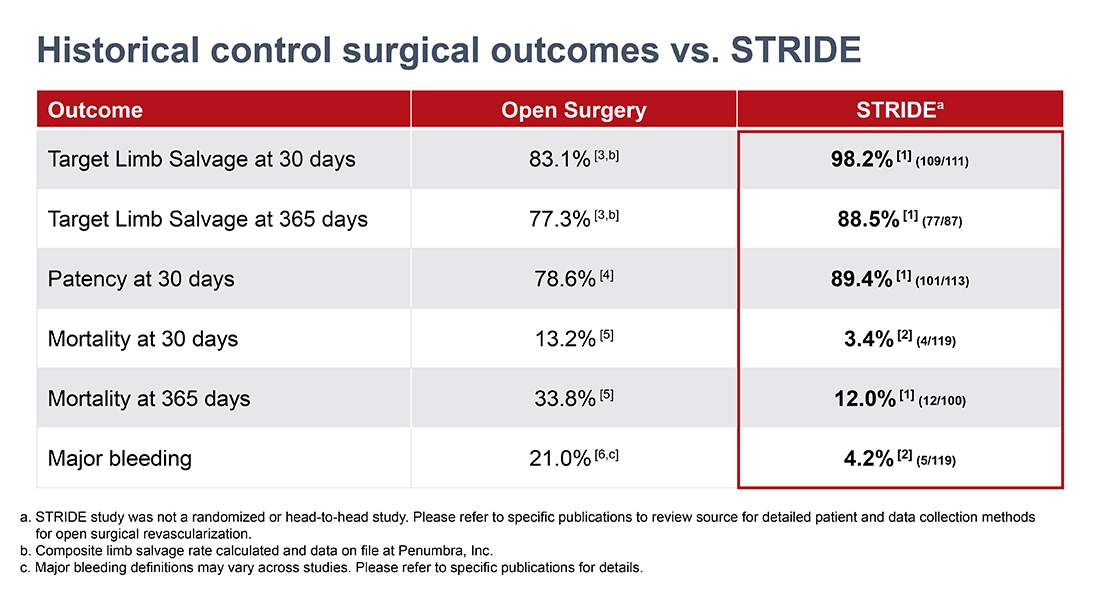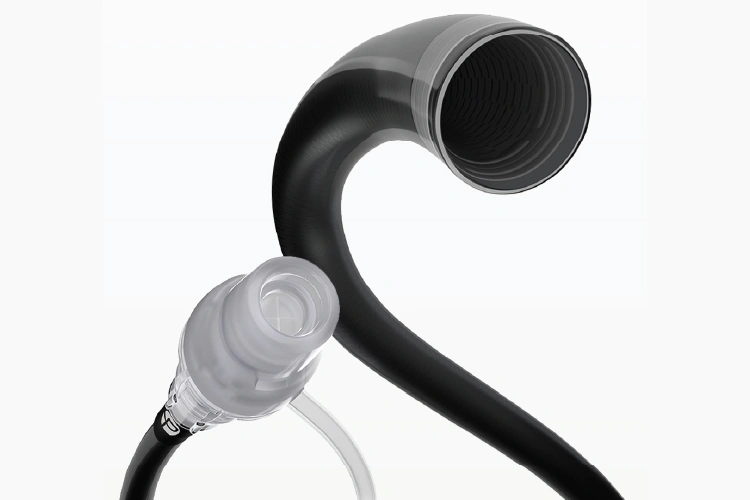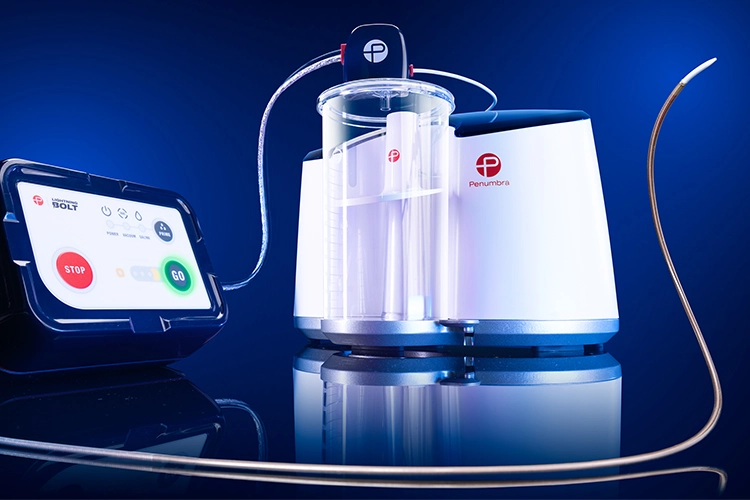One-year Data Demonstrate Firstline Mechanical Thrombectomy with Penumbra’s Indigo®️ Aspiration System Yields High Limb Salvage Rates and Improved Quality of Life for Patients with LE-ALI

One-year limb salvage and quality of life data from the STRIDE Study – showing that frontline use of Penumbra’s Indigo® System for patients with lower extremity acute limb ischemia (LE-ALI) is safe and effective at achieving high limb salvage rates and improving quality of life – has been published in the Journal of Vascular Surgery.1 Results were presented at the Vascular Annual Meeting (VAM) in Chicago, IL, on June 22, 2024.
One-year outcomes1 include:
- 88.5% target limb salvage rate and 12% mortality rate at 365 days, and
- overall improvement in quality of life (QoL), as measured by the VascuQoL-6 questionnaire, from baseline to 1-year follow-up.
The latest results build on evidence from the initial publication of 30-day STRIDE data2, in which the primary endpoint, target limb salvage, was achieved in 98% of patients. The Indigo System was able to achieve these high rates of limb salvage and low rate of mortality with median device time of 22 minutes.
“The latest STRIDE data continue to demonstrate the use of Penumbra’s Indigo® Aspiration System to address LE-ALI results in excellent outcomes, including high target limb salvage rates and quality of life,” said Thomas Maldonado, M.D., national principal investigator of the STRIDE study, and professor of surgery at the New York University of Langone Health. “The data is promising in that it underscores the significant benefits of continuous aspiration to remove thrombus and should be considered a frontline treatment for LE-ALI.”

STRIDE was a multicenter, prospective, single-arm, observational study that enrolled 119 patients across 16 sites in the United States and Europe. The study, which completed follow-up in October 2023, was designed to assess safety and efficacy of mechanical thrombectomy using the Indigo Aspiration System in patients with LE-ALI. Secondary endpoints at 365 days included target limb salvage and mortality. Additionally, the VascuQoL-6 questionnaire, developed for evaluating patient-centered QoL outcomes for peripheral arterial disease, was assessed at baseline and follow-up through 365 days.
ALI, a sudden lack of blood flow to a limb, is associated with a high risk of amputation and death. Early diagnosis and intervention are crucial to improving patient outcomes and preserving limb function.2 Penumbra’s Indigo Aspiration System is a minimally invasive continuous aspiration device that is designed to quickly remove emboli and thrombi from vessels of the peripheral arterial and venous systems.
Important Safety Information
Additional information about Penumbra’s products can be located on Penumbra’s website at https://www.penumbrainc.com/products/peripheral-thrombectomy-indigo-system/. Caution: Federal (USA) law restricts these devices to sale by or on the order of a physician. Prior to use, please refer to Instructions for Use for complete product indications, contraindications, warnings, precautions, potential adverse events, and detailed instructions for use. Risk information can be found at peninc.info/risk.
The clinical results presented herein are for informational purposes only, and may not be predictive for all patients. Individual results may vary depending on patient-specific attributes and other factors.
Sources
1. Maldonado TS, Powell A, Wendorf H, for the STRIDE Study group. One-year limb salvage and quality of life following mechanical aspiration thrombectomy in patients with acute lower extremity ischemia. J Vasc Surg. 2024. Published online. doi: 10.1016/j.jvs.2024.05.043
2. Maldonado TS, Powell A, Wendorff H, et al. Safety and efficacy of mechanical aspiration thrombectomy for patients with acute lower extremity ischemia. J Vasc Surg. 2024;79(3):584–592.e5. doi:10.1016/j.jvs.2023.10.062.
3. Veenstra EB, van der Laan MJ, Zeebregts CJ, et al. A systematic review and meta-analysis of endovascular and surgical revascularization techniques in acute limb ischemia. J Vasc Surg. 2020 Feb;71(2):654–668.e3. doi:10.1016/j.jvs.2019.05.031.
4. Grip O, Wanhainen A, Michaëlsson K, Lindhagen L, Björck M. Open or endovascular revascularization in the treatment of acute lower limb ischaemia. Br J Surg. 2018 Nov;105(12):1598–1606. doi:10.1002/bjs.10954.
5. Taha AG, Byrne RM, Avgerinos ED, et al. Comparative effectiveness of endovascular versus surgical revascularization for acute lower extremity ischemia. J Vasc Surg. 2015 Jan;61(1):147–54. doi:10.1016/j.jvs.2014.06.109.
6. Kolte D, Kennedy KF, Shishehbor MH, et al. Endovascular versus surgical revascularization for acute limb ischemia: a propensity-score matched analysis. Circ Cardiovasc Interv. 2020;13(1):e008150.
Related Articles
-
 Product, Neuro, Clinical, Health
Product, Neuro, Clinical, HealthMIND IDE Trial of Penumbra’s Artemis Neuro Evacuation Device Shows Potential Promise for Patients Experiencing Hemorrhagic Stroke
February 20, 2025 -
 Vascular, Product, Health
Vascular, Product, HealthPenumbra Launches ElementTM Vascular Access System – the First Laser-Cut Hypotube Sheath Designed for Venous Thromboembolism
January 29, 2025 -
 Employee Spotlight
Employee SpotlightEmployee Spotlight: Guadalupe Gutierrez
January 28, 2025 -
 Clinical, Vascular, Product, Health
Clinical, Vascular, Product, HealthLightning Bolt® 6X with TraXTM Case Study: Revascularization of Tibioperoneal Artery with Computer Assisted Vacuum Thrombectomy (CAVTTM)
January 27, 2025
